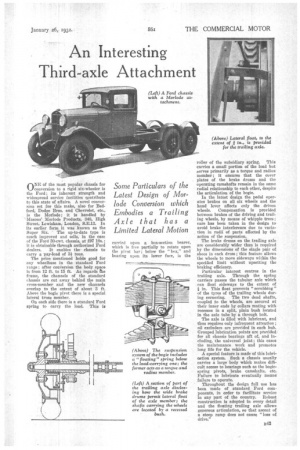An Interesting Third-axle Attachment
Page 57

If you've noticed an error in this article please click here to report it so we can fix it.
nNE of the most popular chassis for IL/conversion to a rigid six-wheeler is the Ford ; its inherent strength and widespread service facilities contribute to this state of affairs. A novel conversion set for this make, also for Bedford, Dodge Bros. and Chevrolet, etc., is the Morlode; it is handled by 'Masons' Morlode Products, 348, High Street, Lewisham, London„ S.E.13. In its earlier form it was known as the
Super Six. The up-to-date type is much improved and sells, in the case of the Ford 30-cwt. chassis, at £97 10s. ; it is obtainable through authorized Ford dealers. It enables the chassis to carry a pay-load of 31 tons.
The price mentioned holds good for any wheelbase in the standard Ford range ; after e.oniersion the body space is from 12 ft. to Hi ft. As regards he frame, the channels of the standard chassis are cut away behind the main cross-member and the new channels overlap to the extent of about 3 ft. Above the bogie pivot there is a special lateral truss member.
On each side there is a standard Ford spring to carry the load. This is carried upon a box-section bearer, which is free partially to rotate upon the pivot bar ; below the "box," and bearing upon its lower face, is the roller of the subsidiary spring. This carries a small portion of the load but serves primarily as a torque and radius member ; it ensures that the cover plates of the brake drums and the operating camshafts remain in the same radial relationship to each other, despite the articulation of the bogie.
In the latest design the pedal operates brakes on all six wheels and the hand lever affects only the driven wheels. Compensation is provided between brakes of the driving and trailing wheels, by means of whipple trees ; care has been taken in the design to avoid brake interference due to variation in radii of parts affected by the action of the suspension.
The brake drums on the trailing axle are considerably wider than is required by the dimensions of the single pair of shoes in each drum ; this feature allows the wheels to move sideways within the specified limit without upsetting the braking efficiency.
Particular interest centres in• the trailing axle. Through the spring carriers passes the tubular axle which can float sideways to the extent of in. This float prevents " scrubbing " of the tyres of the trailing wheels during cornering. The two dead shafts, coupled ,to the wheels, are secured at their inner ends by collars mating with recesses in a split, plain bush located in the axle tube by a through bolt.
The axle is filled with lubricant, and thus requires only infrequent attention ; oil excluders are provided in each hub. Grouped lubrication points are provided for all chassis bearings aft of, and ineluding, the universal joint; this eases the maintenance work and promotes long life for the vehicle.
A special feature is made of this lubrication system. Such a chassis usually carries a large body which makes difficult access to bearings such as the bogiespring pivots, brake camshafts, etc. Failure to lubricate eventually means failure to operate.
Throughout the design full use has been made of standard Ford components, in order to facilitate service in any part of the country. Robust construction is adopted in every detail and the floating trailing axle allows generous articulation, so that ascent of a steep ramp does not cause "loss of drive."






























































































